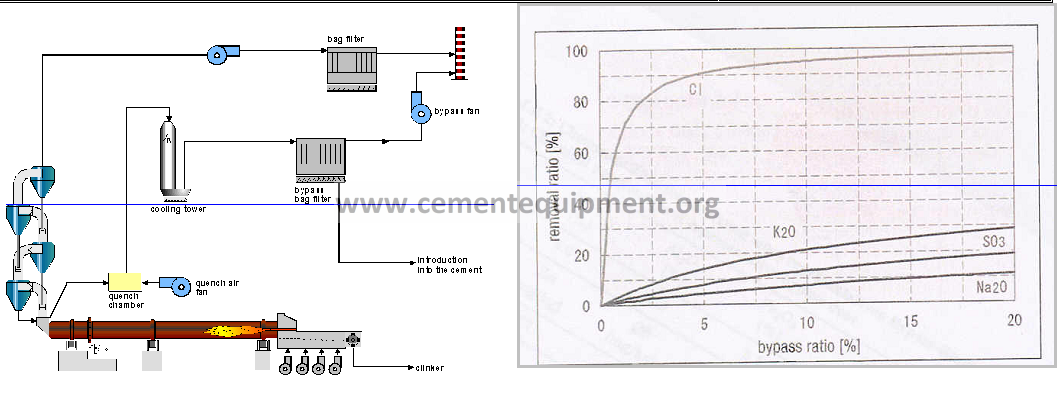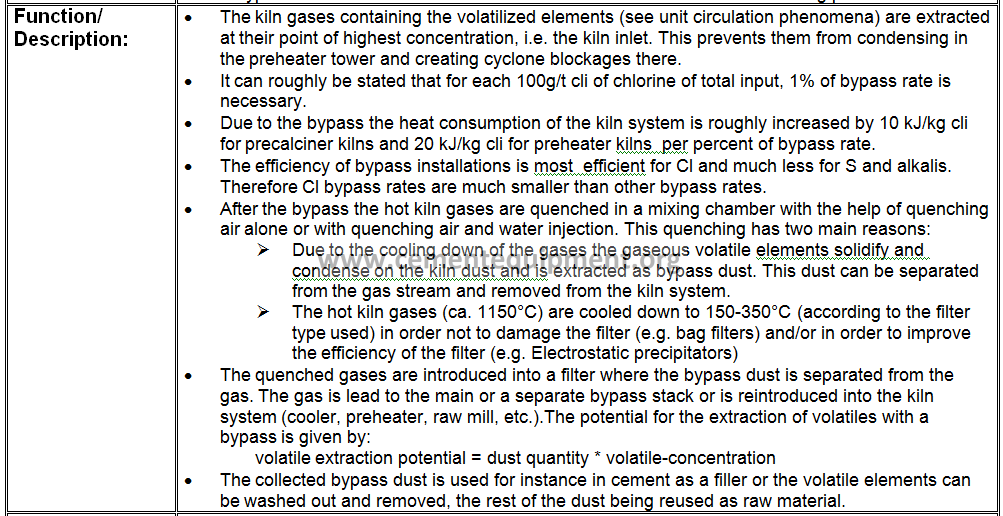Contents
Bypass Principle | short& important notes | 1 minute reading




Bypass Principle
| Purpose: | · A bypass creates a valve for circulating elements in the kiln and removes elements such as Cl, sulfur and alkalis until the coating/clogging situation in the preheater/kiln becomes controllable with the help of cleaning. · A bypass is used for the removal of alkalis in case low-alkali cement is being produced | |
| Function/ Description: | · The kiln gases containing the volatilized elements (see unit circulation phenomena) are extracted at their point of highest concentration, i.e. the kiln inlet. This prevents them from condensing in the preheater tower and creating cyclone blockages there. · It can roughly be stated that for each 100g/t cli of chlorine of total input, 1% of bypass rate is necessary. · Due to the bypass the heat consumption of the kiln system is roughly increased by 10 kJ/kg cli for precalciner kilns and 20 kJ/kg cli for preheater kilns per percent of bypass rate. · The efficiency of bypass installations is most efficient for Cl and much less for S and alkalis. Therefore Cl bypass rates are much smaller than other bypass rates. · After the bypass the hot kiln gases are quenched in a mixing chamber with the help of quenching air alone or with quenching air and water injection. This quenching has two main reasons: Ø Due to the cooling down of the gases the gaseous volatile elements solidify and condense on the kiln dust and is extracted as bypass dust. This dust can be separated from the gas stream and removed from the kiln system. Ø The hot kiln gases (ca. 1150°C) are cooled down to 150-350°C (according to the filter type used) in order not to damage the filter (e.g. bag filters) and/or in order to improve the efficiency of the filter (e.g. Electrostatic precipitators) · The quenched gases are introduced into a filter where the bypass dust is separated from the gas. The gas is lead to the main or a separate bypass stack or is reintroduced into the kiln system (cooler, preheater, raw mill, etc.).The potential for the extraction of volatiles with a bypass is given by: volatile extraction potential = dust quantity * volatile-concentration · The collected bypass dust is used for instance in cement as a filler or the volatile elements can be washed out and removed, the rest of the dust being reused as raw material. | |
| Impact if not correctly functioning | · Clogging in the preheater tower or ring formation in the kiln · Eventually kiln shut down · Cement quality problems in case of low-alkali cement production | |
| Causes of malfunctions | · Inadequate bypass rate (too low) · Too low alkali volatilization and withdrawal (lack of chlorine added) · Erroneous hot meal analysis of volatile elements | |
| Preventive actions | · Correct hot meal analysis of volatile elements at least once per shift · Adjustment of the bypass rate according to the hot meal analysis | |
See site specific unit for additional information, respective corrective actions and applicable safety instructions. | (M) denotes maintenance issue | |